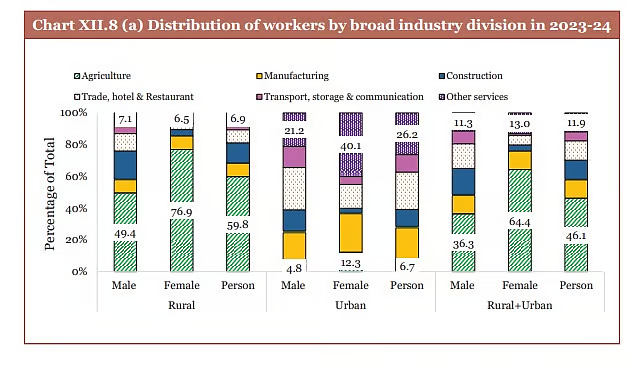Rising Informality of Women in Manufacturing Workforce | 17 Apr 2025
For Prelims: Informal Sector, Formal Sector, Skill India Mission, Digital Saksharta Abhiyan, GDP, Skill India Mission
For Mains: State of Women participation in Manufacturing sector in India, Challenges related to women labor participation, Key Initiatives to Increase Women Labor Force Participation.
Why in News?
The manufacturing sector, contributing approximately 17% to India’s GDP, is considered a key driver for economic growth under the vision of Viksit Bharat. However, women remain significantly underrepresented in the sector, particularly in formal employment, reflecting deeper structural and socio-economic challenges.
Why India Struggles to Generate Enough Formal Jobs?Click Here to Read: Reasons for Declining Formal Jobs in India |
What is the Current Status of Women in Manufacturing in India?
- Formal Sector: Women's share in formal manufacturing has declined from 20.9% in 2015-16 to 18.9% in 2022-23, with only 1.57 million women out of 8.34 million formal workers.
- Tamil Nadu employs the highest share (41%) of women, followed by Karnataka, Maharashtra, Andhra Pradesh, and Gujarat, together accounting for nearly 75% of all women in formal manufacturing.
- Gender disparity is high in Bihar, West Bengal, Chhattisgarh, and Haryana (less than 6% women), and even in industrialised states like Gujarat, Maharashtra, and Uttar Pradesh (less than 15% women).
- In contrast, southern states like Kerala, Karnataka, and Tamil Nadu show relatively better female participation.
- Women are mostly employed in textiles, apparel, and food processing, which make up 60% of female employment.
- Tobacco is the only formal manufacturing industry where more women are employed than men.
- Informal Sector: Women make up 43% of the informal manufacturing workforce, but are mostly employed in low-paying, low-skilled jobs without job security or benefits.
- Key sectors include wearing apparel and tobacco, with over 90% of the informal tobacco workforce being women.
- Gender gap remains high in states like Haryana, Uttar Pradesh, and Gujarat.
- In states like Telangana, Karnataka, and West Bengal, the gender gap is negative, indicating more women than men work in informal manufacturing.

What are the Key Challenges Hindering Female Labour Force Participation in India?Click to Read: Key Reasons for Low Female Participation |
Note
- The government aims to increase manufacturing’s share of GDP to 25% by 2025.
- It promotes manufacturing through schemes like Make in India to boost infrastructure and FDI, Production Linked Incentive Scheme (PLI) to incentivize key sectors, and Samarth to skill women in textiles.
- Skill India provides vocational training, while MUDRA Yojana offers collateral-free loans to women entrepreneurs in manufacturing.
What Steps can Increase Female Labor Participation in the Formal Manufacturing Sector?
- Education and Skill Development: Only 30% of women in manufacturing have completed secondary education (vs 47% of men), and just 6% have formal vocational training.
- To bridge this gap, women’s participation in Skill India Mission and similar initiatives must be expanded, with targeted upskilling in technical and engineering domains to improve access to skilled, better-paying jobs.
- Sectoral Diversification: Women in formal manufacturing are concentrated in a few sectors like textiles and food processing (60%).
- Diversifying their presence into sectors like automotive and electronics through targeted training and incentives is key to improving participation and opportunities.
- Creating Safe Work Environments: Creating safe and inclusive workplaces through hostels, transport, and childcare facilities can boost women’s entry and retention in manufacturing across states.
- Policy Interventions: Strengthening laws like the Maternity Benefit (Amendment) Act and Factories Act can improve working conditions and gender equality.
- To encourage more hiring of women in manufacturing, the government and industry should share the cost of maternity benefits, reducing the financial burden on employers.
Conclusion
Women in India’s manufacturing sector are mainly employed in low-paying, informal jobs with inadequate conditions. To bridge this gap, it is essential to enhance women’s education, skills, and workplace safety, while promoting their shift from informal to formal employment. Establishing an inclusive and supportive environment will empower women and contribute to India’s vision of becoming a "Viksit Bharat."
|
Drishti Mains Question: What are the challenges faced by women in India’s manufacturing sector, and what measures can be taken to enhance their participation and opportunities? |
UPSC Civil Services Examination, Previous Year Questions (PYQs)
Prelims
Q. Increase in absolute and per capita real GNP do not connote a higher level of economic development, if(2018)
(a) industrial output fails to keep pace with agricultural output.
(b) agricultural output fails to keep pace with industrial output.
(c) poverty and unemployment increase.
(d) imports grow faster than exports.
Ans: (c)
Q. Disguised unemployment generally means (2013)
(a) large number of people remain unemployed
(b) alternative employment is not available
(c) marginal productivity of labour is zero
(d) productivity of workers is low
Ans: (c)
Mains
Q. Most of the unemployment in India is structural in nature. Examine the methodology adopted to compute unemployment in the country and suggest improvements. (2023)
Q. “Success of ‘Make in India’ program depends on the success of ‘Skill India’ programme and radical labour reforms.” Discuss with logical arguments. (2015)
Q. “While we flaunt India’s demographic dividend, we ignore the dropping rates of employability.” What are we missing while doing so? Where will the jobs that India desperately needs come from? Explain. (2014)
